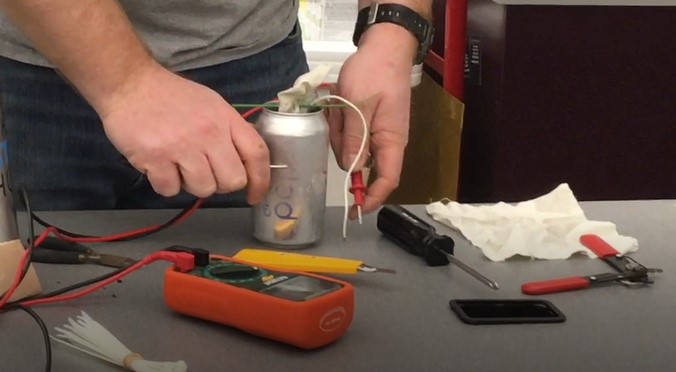Can Batteries
Introduction & Motivation
The batteries you see and use everyday are made from a variety of chemicals. Some, such as nickel and cadmium, are extremely toxic and can cause damage to humans and the environment. In particular, they can cause soil and water pollution, endangering wildlife. Correctly disposing of batteries can help prevent these effects, but other issues still arise such as difficulty in recharging them. Even current rechargeable batteries have limitations.
Thankfully, there is an area of chemical engineering dedicated to improving batteries. In fact, researchers at Tufts are trying to incorporate bio-friendly materials found in common products into batteries to avoid the inherent dangers of commercial batteries and make it easier to dispose of them. You can be a part of this work too! A large company, one of the top makers of renewable energy, wants you to try and build batteries from safe and simple household materials.
Materials
- Aluminum soda cans
- Activated Carbon
- Salt water solution that is 3% salt by weight
- Salt water solution that is 6% salt by weight
- Salt water solution that is 9% salt by weight
- Lemon juice
- Gatorade
- Orange juice
- Copper wire (8″ pieces with ends stripped)
- Hammer
- Wire Strippers
- Multi-meter
- LEDs
- Alligator to alligator wires
- Resistor
- Zip Ties
- Cloth (6″ square pieces)
Procedure
Before beginning the activity, take time to introduce energy storage and batteries. Ask students what they have that are powered by batteries (phones, toys, etc.) and where they think batteries get their energy to power these devices.
Briefly explain the notion of chemical energy and reduction-oxidation (“redox”) reactions to students. If the Reptile Rescue activity has been performed, remind them that they experienced the idea of chemical energy first-hand. Chemical energy refers to the energy stored in the bonds between atoms in a molecule. This energy changes over the course of a reaction: bond creation requires an investment of energy, while bond breaking releases the bond’s energy to the surroundings.
The most fundamental reactions in chemistry are the redox processes. The term redox comes from the two concepts of reduction and oxidation. Reduction describes a molecule or atom that accepts an electron. Oxidation describes a molecule or atom that loses an electron. (There is a handy acronym to remember: OIL RIG — “Oxidation is Loss, Reduction Is Gain”) These two terms go together because in a chemical reaction, one cannot occur without the other. Redox reactions are important because they are the principal sources of energy on this planet! (Oxidation of molecules releases large quantities of energy)
In the conversation of batteries, there are many terms to describe their performance. Three important terms are voltage, current, and resistance. Voltage is the difference in charge between two points, current is about how fast the charge is flowing, and resistance describes how much the material carrying these charges puts up a fight to the flow. Remember, batteries are all about redox reactions, which just move around negatively charged atoms. These moving charges cause power!
When we hear about 9-Volt batteries, this describes the difference in charge between where the charges come out of the battery and where charges go into the battery. This is exactly the way voltage will be measured in this experiment!
Important set-up note:
Cut the tops of the soda cans off and sand down the inside and the edges so that they’re safe for the children to touch and use!
- Lay a piece of cloth out flat and put about ¼ cup of activated carbon in the middle of the cloth. Put the one end of the wire in the activated charcoal and wrap the cloth up around the charcoal and the wire into a pouch so the wire is sticking out at one end.
- Use a zip tie to close the pouch, making sure it is very secure. Clip the excess zip tie off; do not throw this away.
- Have an instructor use a sharp object to cut a hole near the very top of the pouch and slip the excess zip tie through.
- Fill a soda can ¾ of the way full with your electrolyte of choice and suspend the pouch in this.
- Use a multi-meter to measure the current and voltage by touching one wire to the soda can and one wire to the wire sticking out of the pouch and record this along with the electrolytic solution chosen.
- Create one or two more can batteries using different electrolytic solutions and experiment toward increasing the voltage. What happens when you connect the can batteries to each other in a chain (“in series”)? Be sure to illustrate the way the cans are connected when writing down the voltage and current! (See: Wiring Circuits in Series and in Parallel)
- Try to power something! Touch a wire to the can and use the wire coming out of the pouch to connect an LED to the circuit.
**Here is a video tutorial of how to make these batteries!**
Discussion
- After students have experimented with their batteries, ask them to debrief what they saw. What electrolytic solutions gave a high voltage? What household liquids (that are similar to the ones tested) could be used in batteries? Could something other than a liquid be used? (Any salty or acidic solution is electrolytic and should work. Additionally, solid-state electrolytes are being developed for more environmentally friendly batteries!)
- Were there any limitations of the batteries? (Short discharge period, low voltage, etc.)
- How do you wish batteries or the devices they power looked/operated in the future? (Flexible, transparent, sticky, endless power?)

